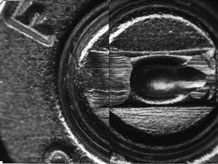|
View in browser: https://www.crime-scene-investigator.net/newsletter/0121.html
|
||
|
JANUARY 2021 | ||
| ||
|
This Month's Featured Resource on the Crime Scene Investigator Network Website
|
||

ATF Police Officer's Guide to Recovered Firearms U.S. Department of Justice This guide is designed for Police Officers and includes the following topics: Firearms Safety, Required Markings, How To Identify Firearms, Tips For Firearms Queries Using Mobile NCIC Terminals, Trace All Recovered Firearms, Persons Prohibited by Federal Law from Possessing Firearms,Questions to Ask Unlawful Firearms Possessors, and Visual Guide to Firearms. |
New CSI and Forensic Job Announcements
|
|
|
The most comprehensive listing of Crime Scene Investigation and Forensic To be notified of job openings as they are posted, follow us on Twitter: Job Posting Alerts |
||
|
Crime Scene Technician
Dallas Police Department, Dallas, Texas, USA Final Filing Date: January 23, 2021 Searches for, collects, processes, packages and preserves physical evidence involved in the crime investigation. (i.e. latent fingerprints, blood samples, shoe impressions, tools, surveillance tapes, I.D., pry-tools). Takes photos of crime scenes and evidence. <View complete job listing> |
||
|
Crime Scene Investigator I
San Antonio Police Department, San Antonio, Texas, USA Final Filing Date: January 25, 2021 Photographs and videotapes crime scene. Searches crime scene thoroughly for physical evidence. Collects, marks, and preserves physical evidence and latent fingerprints. Prepares diagram of crime scene and other reports. Presents forensic evidence in official proceedings. <View complete job listing> |
||
|
Crime Scene Technician I or II
Salt Lake City Police Department, Salt Lake City, Utah, USA Final Filing Date: January 31, 2021 Responsible for the collection, preservation, and analysis of evidence at crime scenes, traffic accidents, and other police related incidents. Documents crime scenes by means of sketches/diagrams and using a variety of photographic techniques and equipment. Writes detailed crime scene reports and maintains photographic files on all evidence collected. <View complete job listing> |
||
|
Evidence and Property Technician
Santa Paula Police Department, Santa Paula, California, USA Final Filing Date: January 24, 2021 Performs a wide variety of specialized law enforcement support duties related to receiving, storing, disposing and releasing of police evidence information, data and property. <View complete job listing> |
||
 |
||
|
Forensic Scientist, Firearms Examiner
Arapahoe County Sheriff's Office, Littleton, Colorado, USA Final Filing Date: December 28, 2020 This position performs a variety of professional crime laboratory/forensic analyses duties related to firearms and toolmarks including identification, documentation, and collection of physical evidence and reconstruction of events as required. <View complete job listing> |
||
|
Forensic Scientist I, II, III
Fort Worth Police Department, Fort Worth, Texas, USA Final Filing Date: February 5, 2021 The forensic biologist would be responsible for examining physical evidence, performing serological analysis, performing DNA testing, interpreting results, preparing lab reports, reviewing case files, and/or presenting results in court. <View complete job listing> |
||
|
Computer Forensic Examiner
Gainesville Police Department, Gainesville, Florida, USA Final Filing Date: February 14, 2021 Conducting thorough and documented preservation, extraction, and analysis of devices in support of Criminal investigations. Assesses crime scenes, both physical and digital, and assists with the execution of search warrants of either. Identifies, collects, inventories, and stores evidence items in a secure manner. Conducts forensic examinations of various media. <View complete job listing> |
||
|
Fingerprint Analyst 1
Miami-Dade Police Department, Doral, Florida, USA Final Filing Date: February 2, 2021 Classifies fingerprints to prescribed formulas and standard classification codes; searches files to locate prior records. Compares and identifies fingerprints in original form or from optical disc display or facsimile machine. Enters fingerprint records into the Automated Fingerprint Identification System for conversion of manual files to automation, and for searching for prior fingerprint record. <View complete job listing> |
||
|
Search for more job listings in Crime Scene Investigations and Forensics To be notified of job openings as they are posted, follow us on Twitter: Job Posting Alerts |
||
|
Other Resources on the Crime Scene Investigator Network Website
|
||
|
Not Subscribed to this Newsletter?
|
||
|
If you are not subscribed to this newsletter, you may subscribe with this link: SUBSCRIBE via email |
||
|
To Unsubscribe
|
||
|
To unsubscribe from future e-mail alerts, please click here: UNSUBSCRIBE Copyright ©2021 Crime Scene Resources, Inc. Crime Scene Investigator Network |

 The examination process typically begins when an examiner receives a suspect firearm, along with bullets (the projectiles) and spent cartridge cases recovered from a crime scene. The gun is test-fired in order to recover bullets and cartridge cases that serve as controls, or better, comparison samples. That is, these test-fired specimens will be compared at multiple levels with the specimens submitted from the crime scene.
The examination process typically begins when an examiner receives a suspect firearm, along with bullets (the projectiles) and spent cartridge cases recovered from a crime scene. The gun is test-fired in order to recover bullets and cartridge cases that serve as controls, or better, comparison samples. That is, these test-fired specimens will be compared at multiple levels with the specimens submitted from the crime scene.

